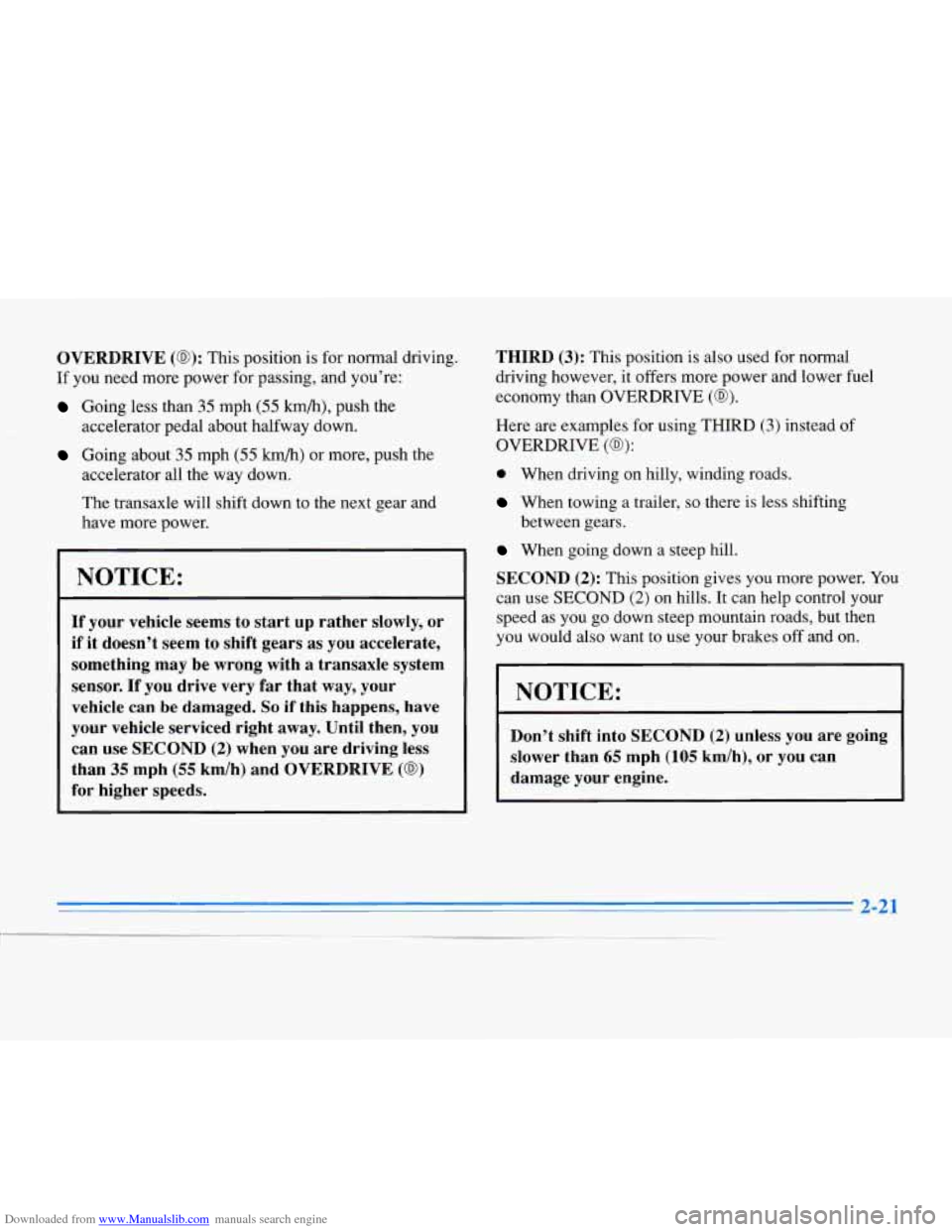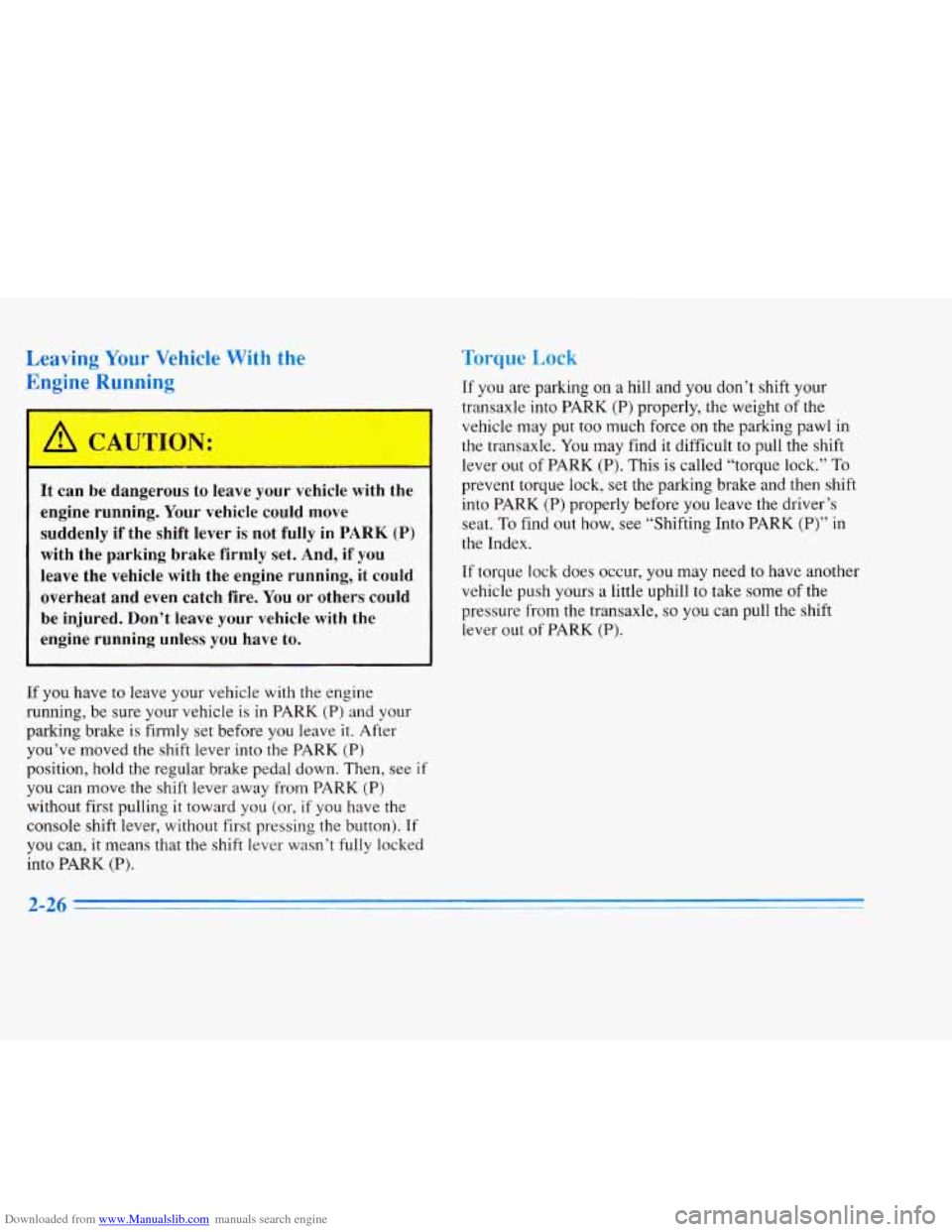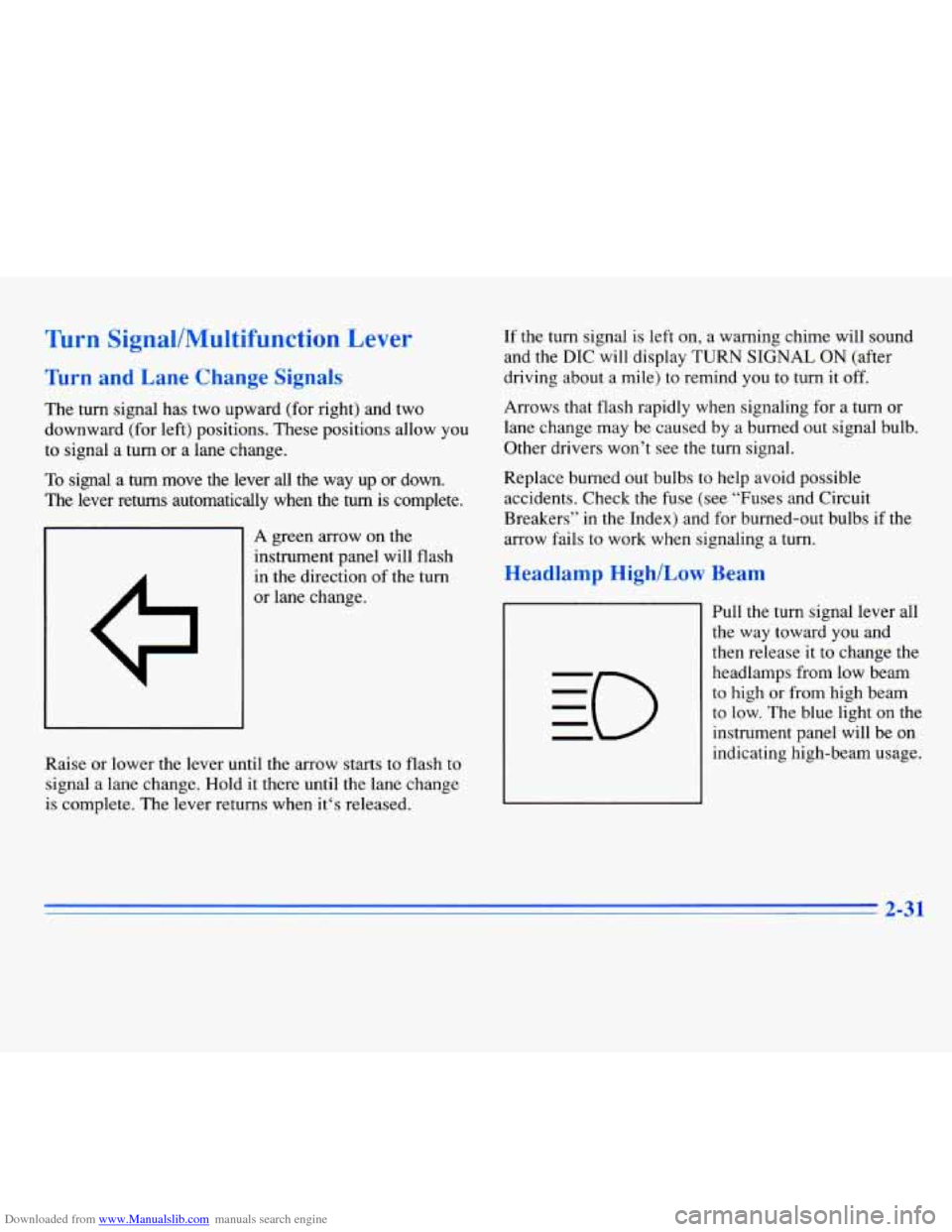Page 82 of 354

Downloaded from www.Manualslib.com manuals search engine OVERDRIVE (0): This position is for normal driving.
If you need more power for passing, and you’re:
Going less than 35 mph (55 km/h), push the
accelerator pedal about halfway down.
Going about 35 mph (55 km/h) or more, push the
accelerator all the way down.
The transaxle will shift down to the next gear and
have more power.
NOTICE:
If your vehicle seems to start up rather slowly, or
if it doesn’t seem to shift gears
as you accelerate,
something may be wrong with
a transaxle system
sensor. If
you drive very far that way, your
vehicle can be damaged.
So if this happens, have
your vehicle serviced right away. Until then, you
can use SECOND
(2) when you are driving less
than
35 mph (55 km/h) and OVERDRIVE (a)
for higher speeds. THIRD
(3): This
position is also used for noma
driving however, it offers more power and lower fuel
economy than OVERDRIVE
(03).
Here are examples for using THIRD (3) instead of
OVERDRIVE (03):
0 When driving on hilly, winding roads.
When towing a trailer, so there is less shifting
When going down a steep hill. between gears.
SECOND
(2): This position gives you more power. You
can use SECOND
(2) on hills. It can help control your
speed as you go down steep mountain roads, but then
you would also want
to use your brakes off and on.
I I
I NOTICE:
Don’t shift into SECOND (2) unless you are going
slower than
65 mph (105 km/h), or you can
damage your engine.
1
Page 84 of 354
Downloaded from www.Manualslib.com manuals search engine Reach under the driver’s side of the instrument panel
and pull
on the manual release lever, which is located
above the parking brake pedal. If the parking brake does
not release, you will have to have your vehicle serviced.
A CAUTION:
-
If your hand or arm is in the way of the pedal,
you could be hurt. The pedal springs back quickly. Keep your hand and arm away when
you use the manual release lever.
NOTICE:
Driving with the parking brak6 bn’can cause
your rear brakes to overheat. You may have to
replace them and you could also damage other
parts
of your vehicle.
If you are towing a trailer and are parking on a hill, see
“Towing a Trailer’’ in the Index. This section shows
what to do first to keep the trailer from moving.
2-23
Page 85 of 354
Downloaded from www.Manualslib.com manuals search engine YYiif“rg Into PARK (P)
It can be dangerous to get out of your vehicle if
the shift lever is not fully in PARK (P) with the
parking brake firmly set. Your vehicle can
roll.
If you have left the engine running, the vehicle
can move suddenly. You
or others could be
injured.
To be sure your vehicle won’t move, even
when you’re on
fairly level ground, use the steps
that follow. If you’re pulling a trailer, see
“Towing
a Trailer” in the Index.
Steering Column Shift Lever
1. Hold the brake pedal down with your right foot.
2. Move the shift lever into the PARK (P) position like this:
I ~~~
Pull the lever toward you.
Page 86 of 354
Downloaded from www.Manualslib.com manuals search engine Move the lever up as far as it will go.
3, With your right foot still holding the brake pedal
down, set the parking brake.
4. Move the ignition key to LOCK.
5. Remove the key and take it with you. If you can
leave your vehicle with the ignition key
in your
hand, your vehicle is in PARK (P).
Console Shift Lever
1. Hold the brake pedal down with your right foot.
2. Move the shift lever into the PARK (P) position like this:
3. Hold in the button on the lever and push the lever all
the way toward the front
of your vehicle.
4. With your right foot still holding the brake pedal
down, set the parking brake.
5. Move the ignition key to LOCK.
6. Remove the key and take it with'you. If you can
leave your vehicle with the ignition key in your
hand, your vehicle is in PARK
(P).
Page 87 of 354

Downloaded from www.Manualslib.com manuals search engine Leaving Your Vehicle With the
Engine Running
It can be dangerous to leave your vehicle with the
engine running. Your vehicle could
move
suddenly if the shift lever is not fully in PARK (P)
with the parking brake firmly set. And, if you
leave the vehicle with
the engine running, it could
overheat and even catch fire. You or others
could
be injured. Don’t leave your vehicle with the
engine running unless
you have to.
If you have to leave your vehicle with the engine
running, be sure your vehicle
is in PARK (P) and your
parking brake
is firmly set before you leave it. After
you’ve moved the shift lever into the PARK
(P)
position, hold the regular brake pedal down. Then, see if
you can move the shift lever away from PARK (P)
without first pulling
it toward you (or, if you have the
console shift lever, without first pressing the button).
If
you can, it means that the shift lever wasn’t fully locked
into
PARK (P).
Torque Lock
If you are parking on a hill and you don’t shift your
transaxle into
PARK (P) properly, the weight of the
vehicle may put too much force
on the parking pawl in
the transaxle. You may find it difficult to pull the shift
lever out of
PARK (P). This is called “torque lock.” To
prevent torque lock, set the parking brake and then shift
into PARK (P) properly before you leave the driver’s
seat.
To find out how, see “Shifting Into PARK (P)” in
the Index.
If torque lock does occur, you may need to have another
vehicle push yours a little uphill to take some of the
pressure from the transaxle,
so you can pull the shift
lever out
of PARK (P).
2-26
Page 90 of 354

Downloaded from www.Manualslib.com manuals search engine Windows
It can be dangerous to get out of your vehicle if
the shift lever is not fully in
PARK (P) with the
parking brake firmly set. Your vehicle can roll.
Don’t leave your vehicle when the engine
is
running unless you have to. If you’ve left the
engine running, the vehicle can move suddenly.
You or others could be injured. To be sure your
vehicle won’t move, even when you’re on fairly
level ground, always set your parking brake after
you move the shift lever to
PARK (P).
Follow the proper steps to be sure your vehicle won’t
move. See “Shifting Into PARK
(P)” in the Index.
If you are parking on a hill and if you’re pulling a
trailer, also see “Towing a Trailer” in the Index.
Power Windows
The controls are
located near each
window. Press the
control forward to
raise the window .and
press rearward to lower. Note that the
second rearward
position on the driver’s
control operates the
express-down
window feature.
Your vehicle has Retained Accessory
Power (RAP).
When you stop your vehicle and turn the ignition key to
OFF, you can still use your power windows. The
electrical power to operate the windows will not shut
off
until you open a door or 10 minutes have passed. If you
want this power for another
10 minutes, turn the key to
RUN and back to OFF.
Page 91 of 354
Downloaded from www.Manualslib.com manuals search engine 111 vv heel
This feature is present on the driver's power window.
Pressing the control rearward into
the second position
then releasing it will lower the window completely. If
you want to stop the window as it is lowering, press
the control forward. Press the control forward to raise
the window.
Note that the first position on the control operates the
driver's power window.
Horn
The horn can be sounded by pressing any surface on the
center steering wheel pad.
Tilt steering allows you to adjust the steering wheel
before you drive. Raising the steering wheel to the
highest level gives your legs nwre room when
you enter
and exit the vehicle.
Hold the steering wheel and pull
the lever toward you to
tilt the wheel. Adjust the steering wheel to a comfortable
position
and then release the lever to lock the wheel
in place.
Page 92 of 354

Downloaded from www.Manualslib.com manuals search engine Turn SignallMultifunction Lever
Turn and Lane Change Signals
The turn signal has two upward (for right) and two
downward (for left) positions. These positions allow you
to signal a turn or a lane change.
To signal a turn move the lever all the way up or down.
The lever returns automatically when the
turn is complete.
A green arrow on the
instrument panel will flash
in the direction of the turn
or lane change.
Raise or lower the lever until the arrow starts
to flash to
signal a lane change. Hold it there until the lane change
is complete. The lever returns when it‘s released. If
the turn signal is left on, a warning chime will sound
and the DIC will display TURN SIGNAL ON (after
driving about a mile) to remind you to turn it
off.
Arrows that flash rapidly when signaling for a turn or
lane change may be caused by a burned out signal bulb.
Other drivers won’t see
the turn signal.
Replace burned out bulbs
to help avoid possible
accidents. Check
the fuse (see “Fuses and Circuit
Breakers” in the Index) and for burned-out bulbs
if the
arrow fails to work when signaling a turn.
Headlamp High/Low Beam
Pull the turn signal lever all
the way toward you and
then release it to change the
headlamps from low beam
to high or from high beam
to low. The blue light on the
instrument panel will be on
indicating high-beam usage.
2-31